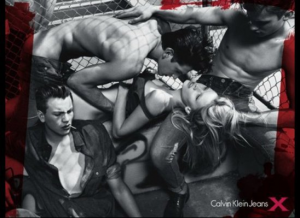The book Visual Persuasion: The Role of Images in Advertising, by Paul Messaris, informs the reader about the ways that advertising communicates messages by using images, which, unlike text, can convey a message that is implicit. Images can mimic the visual world and serve as photographic proof that something has happened; they can elicit emotions by simulating the appearance of a real person or object; and images can establish a link between the product and some other image. By bringing out emotions in people, the images used in advertising can create a message that is impressionable, memorable, and sustained; when information is paired with emotion the neural pathway that is created in the brain is made stronger, which causes an increase in the impact and memorability of the message. Emotion in advertising can be linked to the human need for love, to love and be loved. One example of this emotional reaction is the desire to be loved and the fear of inadequacy that results from not measuring up to the norm of feminine beauty that the media presents as an essential component to falling in love. Women want to be loved, and in order to be loved the media sells to them the idea that they need to attract men in specific ways. Advertisers create a beauty norm, which is one that is nearly to impossible to attain because the norm is presented by specially selected models who fit the norm, and who vigilantly monitor their weight and appearance in order to maintain it. Most of advertised images are photos shopped, furthering the standard o beauty from the appearances of the female population. By creating this idealized beauty standard, the advertisements communicate to girls that they need their products to help them achieve it. This creates fear in women, believing that they do not measure up and are not beautiful, since they do not look like the models in the photos. In order to attract someone and be loved, women feel that they need to change and look more like women in the photos, creating a consumerist society of females that will buy products and keep the companies in business.
It is important for people to critically view images, because by engaging with them and thinking about what the messages are trying to communicate to us, we are able to put an end to becoming passive recipients of the message. When viewers confront the image and critique it, we no longer accept the message unconsciously, but receive it the way we want to. At this point we can get past the false message that a celebrity endorsed cigarette add presents to the viewer, communicating that allure and beauty comes with smoking, and understand it as a misrepresentation of what smoking does to the body and that this add is created to persuade us to buy the product. If an image is presented to us enough times it will become the norm. An example of where this could occur is with the “gang-rape” like ads produced by Dolce and Gabanna and Calvin Klein to sell clothing. In both scenarios there is a group of partially undressed men on top of a woman, some keeping her restrained, and some others acting as bystanders. Once this type of image is repeated enough times, people may consider it the norm; people can learn than male sexuality is about domination and that females enjoy being dominated by men. Since this add projects sexuality and normalcy, people will want to buy clothes to appear sexy and will not have qualms with the images or the message since it is now normal. Once we say that “everyone is doing it”, or “buying it”, than we know that we have bought into the norm, and we have given up our freedom, are following the trends, and are no longer making a decision about the message we have received. To regain autonomy over the message that we will receive, especially one with sexual themes, we can picture, not ourselves, but a female friend, spouse, or family member, in the place of the girl being dominated by those guys. We have then personalized the girl and made her less of an interchangeable model, an object of the photographs message, but a human subject being dominated. Another way to think about these situations is to think about how a child feels about being dominated, e.g. being tied up or hurt; a child’s reaction to bondage and pain is fear and discomfort; bondage and pain has been made sexual through images; the new message is that pain is kinky and that girls like being dominated is created. Thinking about a child’s reaction to these circumstances shows us that these experiences of pleasure are not inherent to humans, but ones that have been made normal or acceptable through the messages projected by advertisements. People desire to create their own ideas about life than to accept ones that have been created to persuade them to think a certain way.
Posted by Kara Campbell
Works Cited
Messaris, Paul. Visual Persuasion: The Role of Images in Advertising. California: SAGE Publications INC, 1997.
“Killing Us Softly 4: Advertising’s Image of Women”. Youtube. 12 March 2010. Web. 6 July 2014. <https://www.youtube.com/watch?v=PTlmho_RovY>




0 responses so far ↓
There are no comments yet...Kick things off by filling out the form below.
You must log in to post a comment.